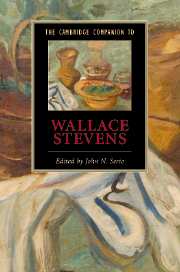Book contents
- Frontmatter
- Introduction
- 1 Wallace Stevens: A Likeness
- 2 Stevens and Harmonium
- 3 Stevens in the 1930s
- 4 Stevens and the supreme fiction
- 5 Stevens’ late poetry
- 6 Stevens and his contemporaries
- 7 Stevens and romanticism
- 8 Stevens and philosophy
- 9 Stevens’ seasonal cycles
- 10 Stevens and the lyric speaker
- 11 Stevens and linguistic structure
- 12 Stevens and painting
- 13 Stevens and the feminine
- 14 Stevens and belief
- Further reading
- Index
1 - Wallace Stevens: A Likeness
Published online by Cambridge University Press: 28 May 2007
- Frontmatter
- Introduction
- 1 Wallace Stevens: A Likeness
- 2 Stevens and Harmonium
- 3 Stevens in the 1930s
- 4 Stevens and the supreme fiction
- 5 Stevens’ late poetry
- 6 Stevens and his contemporaries
- 7 Stevens and romanticism
- 8 Stevens and philosophy
- 9 Stevens’ seasonal cycles
- 10 Stevens and the lyric speaker
- 11 Stevens and linguistic structure
- 12 Stevens and painting
- 13 Stevens and the feminine
- 14 Stevens and belief
- Further reading
- Index
Summary
His soil is man’s intelligence
The countryside around Reading, Pennsylvania, remains today a preserve of the pastoral. A visitor can walk within a half-hour from where Wallace Stevens was born, a handsome three-story brick row house still standing at 323 North Fifth Street, into a dun-colored landscape, patterned by well-tended farms set amid rolling hills and low gray mountains. Amish in their traditional dress, driving horse-drawn carriages, still pass more than occasionally on the narrow roads and lanes outside of the city. Stevens walked again and again into this landscape, from early childhood into young manhood. During summers when he was a boy, he - together with his four siblings and cousins - spent time in the nearby countryside around Ephrata, around Ivyland, and visited his grandparents' farm in Feasterville, where his father had been born. He fished for bass in the same creek, the Perkiomen, where his father had, and played in the same fields, searching for arrowheads and other traces of the native tribes who inhabited this part of western Pennsylvania well into the nineteenth century. “I look back to that farm and the people who lived in it the way American literature used to look back to English literature” (L 732), Stevens wrote in a letter to Thornton Wilder, another who celebrated the earthy, local habitations so quickly vanishing in twentieth-century America.
- Type
- Chapter
- Information
- The Cambridge Companion to Wallace Stevens , pp. 8 - 22Publisher: Cambridge University PressPrint publication year: 2007

